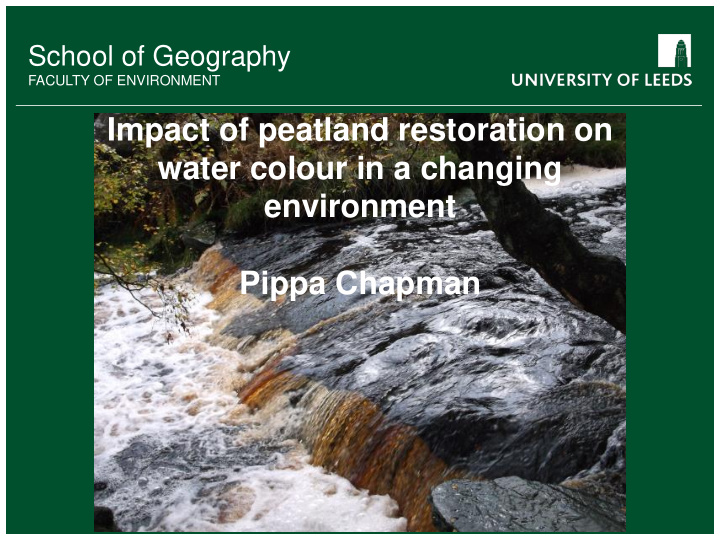



School of something School of Geography FACULTY OF OTHER FACULTY OF ENVIRONMENT Impact of peatland restoration on water colour in a changing environment Pippa Chapman
School of Geography FACULTY OF ENVIRONMENT Structure of presentation Peatlands and regulation of water quality How water colour has changed over last 30 years Why water colour is an issue Impact of peatland restoration on water colour versus other environmental changes in the UK uplands Conclusion
School of Geography FACULTY OF ENVIRONMENT Precipitation = main input of water and solutes Characteristics of water draining peatlands: • Low ionic strength - due to low solute concentrations • Acidic – low pH • Oligotrophic - low nitrogen and phosphorus concentrations • Coloured due to the presence of dissolved organic carbon (DOC)
School of Geography FACULTY OF ENVIRONMENT Ecosystem services of peatlands with regard to regulating water quality 1. In the UK 11.4 million people rely on 3. Peat retains pollutants peatlands for their drinking water 4. Source of dilute water: can be 2. Source of potable water due to used to dilute pollutants in other • High rainfall amount water sources • Low evapotranspiration • Remote location • Low intensity land use • High water quality
School of Geography FACULTY OF ENVIRONMENT Water picks up colour (dissolved organic carbon) as it passes through the peat Water treatment removes colour so that customers receive a colourless water
School of Geography FACULTY OF ENVIRONMENT Water colour has increased over 20 years Trend in colour at Water Treatment Works in the southern Pennines
School of Geography FACULTY OF ENVIRONMENT Environmental Implications of increasing water colour Depletion of terrestrial carbon stores , increasing fluxes into more reactive pools (riverine, marine and ultimately atmospheric). Impact for water treatment works (increased cost) and potential effects on drinking water quality (production of carcinogenic disinfection by-prodcuts). Local effects on water quality : Water transparency; water temperature, acidity; heavy metals; ecology.
School of Geography FACULTY OF ENVIRONMENT Why has water colour increased? Carbon more soluble as acidity declines Decline in Acid Rain 16 14 12 DOC (mg/L) 10 8 6 4 2 4 6 8 10 12 14 16 Sulphate (mg/L)
School of Geography FACULTY OF ENVIRONMENT Can peatland restoration help? • YES but often hard to detect from sampling stream water alone due to seasonal trend and long term trend
School of Geography FACULTY OF ENVIRONMENT Influence of water-table position High water table Low water table Anaerobic Aerobic (no oxygen) (oxygen) DOC µg/g 0.52 1.98 soil/day DOC 1.84 3.53 More colour Less colour Q10 produced produced Clark et al., 2009. Global Change Biology
School of Geography FACULTY OF ENVIRONMENT Drainage and water colour/DOC Wallage et al., 2006. Science of the Total Environment .
School of Geography FACULTY OF ENVIRONMENT Impact of drain-blocking on water colour Many studies observed an increase in colour shortly after blocking (e.g. Worrall et al. 2007). Large study showed that blocking generally reduced colour (Armstrong et al., 2010). But not always - Impact of local conditions Re-vegetation of gullies reduces loss of peat to freshwaters
School of Geography FACULTY OF ENVIRONMENT Re-vegetation of bare peat at Bleaklow DOC flux t C km -2 yr -1 Bare peat 34.4 – 72.1 less peat and Restored 13.1 – 57.7 More peat and colour lost from colour lost from Vegetated 13.0 – 95.6 vegetated peat bare peat Worrall et al. (2011)
School of Geography FACULTY OF ENVIRONMENT Heather Burning and DOC However, plot scale experiments have not observed an increase in Yallop & Clutterbuck, 2009. Science of the Total soil solution DOC following burning Environment (e.g. Clay et al., 2009; 2010).
School of something School of Geography FACULTY OF OTHER FACULTY OF ENVIRONMENT How will water colour change in the future?
School of Geography FACULTY OF ENVIRONMENT Air Pollution Climate Change Land Use Change & Peatland Restoration Surface Water Chemistry
School of Geography FACULTY OF ENVIRONMENT Water colour over next 10 years 2 1 in 100-year 1.5 1 in 50-year 1 in 10-year 1 1 in 2-year Z-score (colour) 0.5 0 -0.5 -1 -1.5 -2 1980 1985 1990 1995 2000 2005 2010 2015 2020 2025 2030 2035 observed Modelled 100yr_rf-sum 50yr_rf-sum 10yr_rf-sum 2yr_rf-sum Major impact of recovery from acid rain has happened Climate change and land use change/restoration will have more influence
School of Geography FACULTY OF ENVIRONMENT A restored peatland is more resilient to climate change Any Questions?
School of Geography FACULTY OF ENVIRONMENT Acknowledgments Yorkshire Water – data and funding for research UK Uplands Water Monitoring Network – River Etherow data Sheila Palmer, Brian Irvine, Joseph Holden
Recommend
More recommend